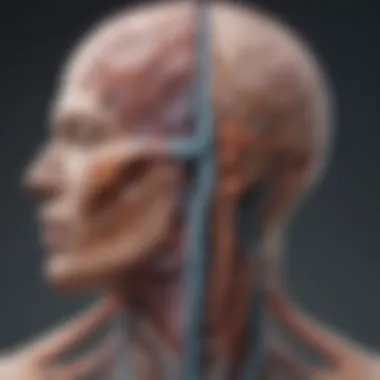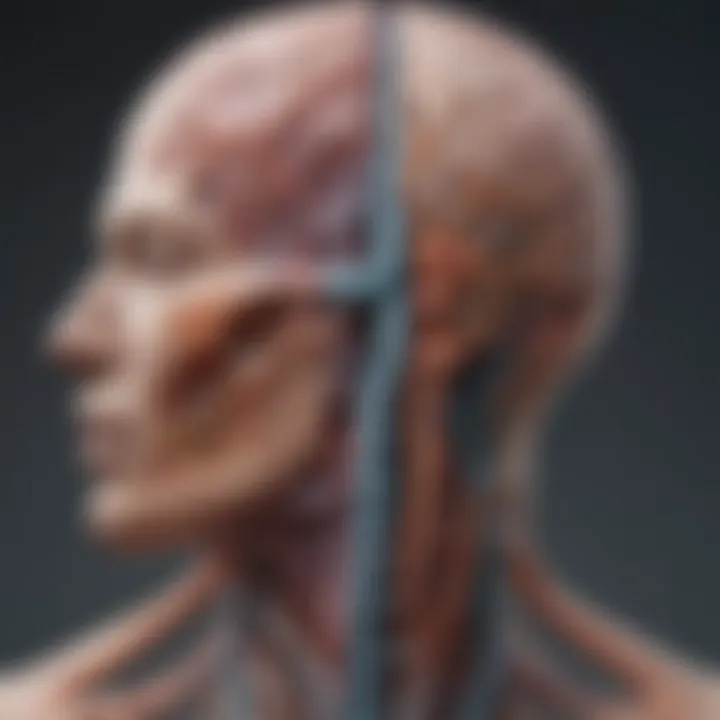Exploring the Autonomic Nervous System's Depths


Intro
The autonomic nervous system (ANS) plays a vital role in maintaining homeostasis within the human body. It operates automatically, managing a range of unconscious processes like heart rate, digestion, and respiratory rate. Understanding this system is critical for multiple fields, including medicine, psychology, and even sports science. As we delve deeper into the ANS, it becomes clear that its complexity reflects not only physiological mechanisms but also broader implications for health and disease.
Article Overview
Purpose of the Article
This article aims to elucidate the intricacies of the autonomic nervous system. By exploring foundational concepts, it seeks to clarify how the ANS influences bodily functions and how it adapts to varying conditions. Readers will gain insights into the divisions of the ANS, its pathways, and the physiological responses it triggers in different scenarios.
Moreover, the article examines the impact of external factors on the ANS, including stress and other emotional states. As we connect these dots, we highlight the clinical significance of the ANS, emphasizing its role in health care and disease management.
The information presented aims to be accessible for students and professionals alike, paving the way for understanding both common and complex conditions.
Relevance to Multiple Disciplines
The autonomic nervous system intersects with numerous disciplines. Its relevance extends to:
- Medicine: Understanding how the ANS affects healing and disease processes is essential for developing treatments.
- Psychology: The ANS plays a crucial role in emotional regulation and stress response, influencing mental health.
- Sports Science: Knowledge of the ANS can help optimize physical performance and recovery.
- Neuroscience: Exploring how the ANS functions at a neuronal level broadens our comprehension of the nervous system as a whole.
Research Background
Historical Context
The understanding of the autonomic nervous system underwent significant evolution. Early studies concentrated on the sympathetic and parasympathetic divisions, with articulations dated back to ancient Greek medicine. However, it was not until the 19th century that key discoveries were made regarding how these systems function and interact.
Important figures, such as Wilhelm Wundt, contributed to our present understanding by linking psychological states to physiological responses mediated by the ANS.
Key Concepts and Definitions
Several key concepts are vital for a comprehensive understanding of the ANS.
- Sympathetic Nervous System: Often referred to as the 'fight or flight' system, this division responds to stressors by preparing the body for action. It raises heart rate, dilates pupils, and inhibits digestion.
- Parasympathetic Nervous System: This system promotes the 'rest and digest' phase, facilitating recovery and the maintenance of normal functions, such as increasing digestive activity.
- Homeostasis: A state of balance that the ANS strives to maintain across various bodily systems.
Understanding these concepts sets the stage for exploring the more complex interactions within the autonomic nervous system, and its widespread impacts across different physiological and psychological domains.
"The autonomic nervous system connects the brain's centers of regulation to the body’s muscles, glands, and organs, influencing all involuntary actions."
"The autonomic nervous system connects the brain's centers of regulation to the body’s muscles, glands, and organs, influencing all involuntary actions."
As we proceed, this article will integrate current knowledge while addressing nuances in autonomic function.
Prologue to the Autonomic Nervous System
The autonomic nervous system is essential for the functioning of the human body. Understanding its role is crucial for students, researchers, and professionals who are interested in physiology, medicine, and health sciences. This system governs involuntary processes, such as heart rate, digestion, and respiratory rate. It operates largely without conscious control, making its study valuable.
Knowledge of the autonomic nervous system provides insights into various physiological and pathological states. For example, stress can significantly impact its function, leading to various health issues. Thus, comprehending this system is not just a matter of academic interest, but also a necessity in clinical practice.
Definition and Overview
The autonomic nervous system is a subdivision of the peripheral nervous system. It divides into three main parts: sympathetic, parasympathetic, and enteric. Each of these components has distinct roles and functions, which are vital for homeostasis. The sympathetic nervous system triggers the fight-or-flight response during stressful situations, increasing heart rate and preparing the body for rapid actions. The parasympathetic side counteracts these changes, supporting rest and digestion activities.
Interactions between these systems maintain balance in bodily functions. The autonomic nervous system relies on signaling pathways consisting of neurotransmitters and receptors to communicate and regulate the activities of internal organs.
Historical Context
The study of the autonomic nervous system has a rich history that stretches back to early medical observations. In the 19th century, researchers such as Claude Bernard started to uncover its significance in internal processes. Understanding expanded through advances in anatomy and physiology.
By the early 20th century, major discoveries about neurotransmitters changed how scientists perceived the system. They learned how certain chemicals, like acetylcholine and norepinephrine, play critical roles in autonomic function. Ongoing research continues to unveil how these functions relate to broader health concerns.
In summary, the autonomic nervous system is a critical subject matter in both modern physiology and clinical settings. Understanding it sets a foundation for further exploration into health and disease management. Its historical context enriches our appreciation for the intricate nature of bodily functions.
Anatomical Structure of the Autonomic Nervous System
Understanding the anatomical structure of the autonomic nervous system (ANS) is crucial because it provides the framework for how this complex system operates and affects the human body. The ANS plays a fundamental role in regulating involuntary physiological functions, which include heart rate, digestion, respiratory rate, and pupillary response. With an intricate arrangement of neurons and connections, the ANS ensures seamless communication between various body systems.
Central Nervous System Integration
The central nervous system (CNS) is the command center for the autonomic nervous system. It primarily consists of the brain and spinal cord, where integration occurs. Within the brain, various regions contribute to the regulation of autonomic functions. For instance, the hypothalamus plays a pivotal role in maintaining homeostasis by linking the autonomic nervous system with the endocrine system. This integration enables responses to internal changes in the body, such as fluctuations in temperature or stress levels.
Moreover, the brainstem is critical for basic autonomic functions. Structures such as the medulla oblongata manage vital actions, including blood pressure and respiratory control. Therefore, without the proper integration of the CNS, the autonomic responses would be impaired, leading to potential detrimental health effects.
Peripheral Nervous System Components
The peripheral nervous system (PNS) extends beyond the brain and spinal cord, consisting of nerves that communicate signals between the CNS and the rest of the body. The PNS has two main components relevant to the ANS: the sympathetic and parasympathetic nervous systems.
- Sympathetic Nervous System: Often termed the "fight or flight" system, it prepares the body for intense activities. Its pathways emerge from the thoracic and lumbar regions of the spinal cord. The sympathetic nerves release neurotransmitters like norepinephrine, increasing heart rate and redirecting blood flow to muscles.
- Parasympathetic Nervous System: This system counters the sympathetic response and is often referred to as the "rest and digest" system. It originates from the brain and sacral region of the spinal cord. The parasympathetic pathway typically uses acetylcholine as a neurotransmitter, which promotes relaxation and supports processes related to digestion and energy conservation.
The balance between these two systems ensures that the body can adapt to various stressors and maintain a stable internal environment. Without this intricate anatomical structure and the functional connection between the CNS and the PNS, the body would struggle to adequately respond to everyday challenges and stressors.


"The autonomic nervous system showcases the remarkable ability of the human body to self-regulate and respond to varying internal and external stimuli. Its anatomical structure is complex yet essential for life."
"The autonomic nervous system showcases the remarkable ability of the human body to self-regulate and respond to varying internal and external stimuli. Its anatomical structure is complex yet essential for life."
Divisions of the Autonomic Nervous System
The autonomic nervous system plays an essential role in maintaining homeostasis within the human body. Understanding its divisions helps to clarify how involuntary physiological functions are orchestrated. The system is primarily divided into three components: the sympathetic nervous system, the parasympathetic nervous system, and the enteric nervous system. Each division operates synergistically but maintains distinct pathways and functions, allowing the body to balance its response to internal and external stimuli. This segmentation underscores the complexity of autonomic regulation and highlights the significance of these divisions in both health and disease.
Sympathetic Nervous System
The sympathetic nervous system (SNS) is often described as the ‘fight or flight’ system. This division prepares the body for stressful situations by increasing heart rate, dilating air passages, and boosting blood flow to muscles. Key features of the SNS include the release of neurotransmitters such as norepinephrine and epinephrine. These chemicals facilitate rapid communication between neurons and target organs, resulting in immediate physiological changes.
Important functions of the sympathetic nervous system:
- Increased heart rate and blood pressure to enhance circulation.
- Dilated pupils for improved vision in low light conditions.
- Inhibited digestion as energy is directed to more critical systems during stress.
The SNS is particularly important in situations requiring quick, decisive action. However, chronic activation can lead to health issues like hypertension and anxiety.
Parasympathetic Nervous System
In contrast, the parasympathetic nervous system (PNS) is regarded as the ‘rest and digest’ system. It plays a crucial role in conserving energy and maintaining functions during restful periods. Upon activation, the PNS reduces heart rate, stimulates digestion, and fosters a state of relaxation. Acetylcholine is the primary neurotransmitter involved in this division, facilitating communication between nerves and organs.
Key characteristics of the parasympathetic nervous system include:
- Stimulating saliva production, aiding in digestion.
- Promoting peristalsis, which is crucial for the digestive process.
- Conserving energy by slowing the heart rate and lowering blood pressure.
The balance between the sympathetic and parasympathetic systems is vital for overall health. When one system is dominant, proper physiological functioning is jeopardized, leading to various disorders.
Enteric Nervous System
The enteric nervous system (ENS), often termed the 'second brain,' governs gut function independently, though it communicates with both the sympathetic and parasympathetic systems. It consists of two primary plexuses: the myenteric plexus, which manages gut motility, and the submucosal plexus, which controls enzyme secretion and blood flow to the gut.
Distinct features of the enteric nervous system include:
- Regulation of gastrointestinal activities, such as peristalsis and enzyme secretion.
- Integration with local and central nervous systems, allowing complex reflex actions.
- Influence by bacteria, as gut microbiota can alter ENS function and, consequently, overall health.
The ENS's significant control over gut processes makes it fundamental not only for digestion but also for broader health outcomes. Dysregulation of the ENS may lead to gastrointestinal disorders, which illustrate its importance in maintaining the body's equilibrium.
The divisions of the autonomic nervous system—sympathetic, parasympathetic, and enteric—work in tandem, ensuring that the body responds effectively to both immediate and long-term physiological needs. Understanding these systems is key in fields ranging from medicine to neuroscience.
The divisions of the autonomic nervous system—sympathetic, parasympathetic, and enteric—work in tandem, ensuring that the body responds effectively to both immediate and long-term physiological needs. Understanding these systems is key in fields ranging from medicine to neuroscience.
In sum, studying the divisions of the autonomic nervous system provides insight into how they contribute to the homeostatic processes essential for life.
Functional Mechanisms
The functional mechanisms of the autonomic nervous system are crucial for understanding how this system operates within the body. It governs various involuntary physiological functions, ensuring homeostasis and a balanced internal environment. By delineating specific enzymatic pathways and neurochemical processes, one can appreciate the fine-tuning involved in bodily responses to both internal and external stimuli. This section elucidates two essential components of these mechanisms: neurotransmitters along with their receptors, and the operation of reflex arcs, both of which facilitate rapid and adaptable responses to a myriad of conditions.
Neurotransmitters and Receptors
Neurotransmitters play a pivotal role in the autonomic nervous system by acting as chemical messengers. They are responsible for transmitting signals across synapses between neurons, influencing the activity of organs and tissues. Key neurotransmitters include acetylcholine, norepinephrine, and epinephrine.
- Acetylcholine primarily mediates the parasympathetic nervous system responses. It is involved in promoting digestion and recovery processes.
- Norepinephrine, on the other hand, is a principal neurotransmitter of the sympathetic nervous system. It prepares the body for a ‘fight or flight' response by increasing heart rate and blood flow to muscles.
- Epinephrine, also known as adrenaline, works closely with norepinephrine during acute stress responses, enhancing metabolic activity.
The action of these neurotransmitters is mediated through a variety of receptors, including:
- Muscarinic receptors (respond to acetylcholine) are primarily found in the heart and smooth muscle.
- Adrenergic receptors (respond to norepinephrine and epinephrine) are abundant in the heart, lungs, and blood vessels.
Each receptor type is tied to specific physiological effects, which can aid in targeted therapeutic strategies. Understanding these interactions contributes to advances in various fields, especially in clinical medicine.
Reflex Arcs and Autonomic Responses
Reflex arcs illustrate a fundamental mechanism by which the autonomic nervous system operates. They provide a framework for how certain stimuli can provoke immediate responses, often without the need for conscious thought. The structure of a reflex arc typically includes:
- Receptor: Detects changes in the environment, such as pain or temperature.
- Sensory neuron: Transmits information to the central nervous system.
- Integration center: Processes the information and determines an appropriate response.
- Motor neuron: Carries the response signals from the central nervous system to the target muscles or organs.
- Effector: Executes the response.
These pathways allow for instant reactions such as withdrawing a hand from a hot surface. In the context of autonomic responses, reflex arcs regulate critical functions such as heart rate, digestion, and respiratory rate.
These pathways allow for instant reactions such as withdrawing a hand from a hot surface. In the context of autonomic responses, reflex arcs regulate critical functions such as heart rate, digestion, and respiratory rate.
Understanding reflex arcs expands one's comprehension of how autonomic processes support bodily functions during varying conditions, thereby highlighting the importance of a well-regulated autonomic nervous system in overall health and function. It also underlines the complexities involved in responses to stressors and the adaptation mechanisms at play.
In summary, the functional mechanisms of neurotransmitters, receptors, and reflex arcs are fundamental to the operability of the autonomic nervous system. They demonstrate how the body achieves balance and responds dynamically to its environment.


Physiological Responses Governed by the Autonomic Nervous System
The autonomic nervous system (ANS) plays a crucial role in regulating a variety of physiological responses in the body. It governs functions that are primarily involuntary, allowing the body to maintain homeostasis. Understanding how these responses are orchestrated by the ANS is essential not only for students and researchers in neuroscience and biology but also for medical professionals who need to comprehend the implications of autonomic regulation in health and disease.
The physiological responses governed by the ANS include heart rate, blood pressure, thermoregulation, and digestion. By exploring these areas, we highlight the significance of the ANS in daily life and its involvement in various clinical contexts. The ability of the ANS to adapt to internal and external stimuli demonstrates its importance in sustaining our body's functions during different conditions.
Heart Rate and Blood Pressure Regulation
Heart rate and blood pressure are continuously regulated by the ANS. The sympathetic division prepares the body for action by increasing heart rate and elevating blood pressure. This response is crucial during situations of stress or danger, often referred to as the fight-or-flight response. Neurotransmitters like norepinephrine play a key role in facilitating this rapid adjustment.
In contrast, the parasympathetic division works to calm the body down after a stressful episode by lowering heart rate and blood pressure through the release of acetylcholine. This mechanism is important for recovery and relaxation, ensuring that the body does not remain in a constant state of heightened alertness.
Both divisions function through complex feedback loops involving baroreceptors, which detect changes in blood pressure and send signals to the brain for appropriate adjustments. This interplay is vital for cardiovascular health, preventing chronic conditions such as hypertension.
Thermoregulation Mechanisms
Thermoregulation is another critical function controlled by the ANS. The body strives to maintain a core temperature of approximately 37 degrees Celsius. When the body becomes too hot, the sympathetic system triggers sweating and dilates blood vessels in the skin. This allows for heat dissipation through evaporation and increased blood flow to the skin surface, facilitating cooling.
Conversely, when the body temperature drops, the parasympathetic system constricts blood vessels and stimulates shivering. Shivering generates heat through muscle activity, while constriction of blood vessels helps to conserve core body temperature. The hypothalamus in the brain serves as the body's thermostat, making two key bodily responses automatic.
Digestive System Control
The ANS also plays a significant role in managing digestive processes. The enteric nervous system, often termed the "second brain," operates with considerable autonomy. However, it remains influenced by both the sympathetic and parasympathetic divisions.
During the rest-and-digest phase, the parasympathetic system promotes digestion by stimulating saliva production, gastric secretions, and peristalsis. These actions facilitate nutrient absorption and processing. Conversely, the sympathetic system can inhibit these processes during stress, diverting energy away from digestion to more immediate survival needs.
This regulation highlights how external stressors can affect gastrointestinal health and overall wellness. Conditions such as irritable bowel syndrome illustrate the direct consequences of autonomic imbalance on digestive function.
The autonomic nervous system is crucial in maintaining homeostasis and responding to environmental challenges through physiological changes.
The autonomic nervous system is crucial in maintaining homeostasis and responding to environmental challenges through physiological changes.
Influence of External Factors on the Autonomic Nervous System
The autonomic nervous system plays a crucial role in managing the body’s involuntary functions. However, it does not operate in isolation. Various external factors greatly influence its functioning. Understanding these influences can provide insight into both normal physiological processes and clinical conditions. Factors like stress and environmental changes can have significant impacts on how the autonomic nervous system operates, affecting health and overall well-being.
Stress and Its Modulatory Effects
Stress is one of the most recognized external factors affecting the autonomic nervous system. When an individual experiences stress, the body activates the sympathetic branch. This leads to an increase in heart rate, blood pressure, and energy mobilization. The acute response, known as the fight-or-flight reaction, prepares the body to face perceived threats.
Chronic stress, however, can lead to maladaptive changes in autonomic regulation, contributing to health issues such as hypertension, anxiety disorders, and diabetes. Stress can alter neurotransmitter levels, including norepinephrine and cortisol, which may affect how the body manages responses to stressors.
The relationship between stress and the autonomic nervous system is intricate. For instance:
- Increased sympathetic tone creates physiological changes that can be harmful if sustained over time.
- Dysfunctions in feedback mechanisms can lead to conditions such as post-traumatic stress disorder (PTSD).
To mitigate these effects, individuals may engage in relaxation techniques such as mindfulness, deep breathing, and yoga. These practices can help rebalance autonomic functions by enhancing parasympathetic activity, restoring a state of calm and balance.
"Understanding the impact of stress on the autonomic nervous system is key to developing effective interventions for stress-related health issues."
"Understanding the impact of stress on the autonomic nervous system is key to developing effective interventions for stress-related health issues."
Environmental Influences
Environmental factors can also significantly affect the autonomic nervous system. Changes in temperature, humidity, and even air quality can lead to physiological adaptations mediated by the autonomic system. One notable example is thermoregulation, which depends heavily on signals from the environment.
- Heat: In warmer conditions, the body initiates vasodilation, increasing blood flow to the skin to enhance heat loss.
- Cold: Conversely, in cold environments, vasoconstriction occurs, conserving body heat and protecting internal organs.
- Air Quality: Poor air quality can trigger the autonomic nervous system’s response, leading to increased heart rate and inflammation, highlighting how environmental stressors can disrupt normal functions.
These influences illustrate how external elements can cause immediate or prolonged changes in autonomic regulation. Those working in areas of urban planning, public health, and environmental science might consider these interactions to promote healthier environments. Understanding both stress and environmental influences on the autonomic nervous system can lead to better health outcomes and targeted interventions for various populations.
By acknowledging the powerful external factors influencing the autonomic nervous system, healthcare providers can tailor treatment strategies that address these influences. This understanding is essential for developing comprehensive healthcare approaches in an increasingly complex world.
Clinical Implications of Autonomic Dysregulation
Understanding the clinical implications of autonomic dysregulation is crucial for both healthcare professionals and researchers. The autonomic nervous system (ANS) plays a significant role in maintaining homeostasis and regulating numerous involuntary bodily functions. When this system is disrupted, it can have widespread effects on health. The dysregulation can lead to various symptoms and conditions that might compromise an individual's quality of life. Evaluating and managing these implications is essential in addressing patient care and advancing medical knowledge.
Autonomic Neuropathies
Autonomic neuropathies refer to disorders that damage the autonomic nerves. These disruptions can hinder the transmission of signals between the brain and the rest of the body, leading to a range of symptoms. Some common conditions associated with autonomic neuropathies include diabetes, alcoholism, and certain genetic disorders. Symptoms vary widely and can affect different systems:
- Cardiovascular dysregulation: This can manifest as orthostatic hypotension, where a sudden change in position causes significant drops in blood pressure.
- Gastrointestinal problems: Issues such as gastroparesis can arise, leading to delayed gastric emptying and subsequent complications like nausea and vomiting.
- Urinary dysfunction: This includes complications in bladder control and retention issues.
Diagnosing autonomic neuropathies often involves autonomic function tests, such as heart rate variability assessments or baroreflex sensitivity tests. Treatment generally focuses on symptomatic relief and managing the underlying cause of the neuropathy.


"Early diagnosis and management of autonomic neuropathies can significantly improve patient outcomes."
"Early diagnosis and management of autonomic neuropathies can significantly improve patient outcomes."
Impact on Chronic Diseases
Dysregulation of the autonomic nervous system can significantly influence chronic diseases. Conditions such as hypertension, heart failure, and even certain mental health disorders like anxiety and depression have shown a link to autonomic dysfunction. For instance, individuals with chronic diseases often show altered autonomic tone, which can exacerbate their condition. Key areas include:
- Cardiovascular health: Autonomic imbalance can lead to increased heart rate variability or arrhythmias, complicating the management of heart diseases.
- Metabolic syndrome: Autonomic dysregulation may impair glucose metabolism, leading to insulin resistance and contributing to obesity.
- Mental health disorders: The stress response governed by the autonomic nervous system has implications in anxiety and mood disorders. Dysregulation here may worsen symptoms, creating a cycle that can be hard to break.
Long-term, the intersection between autonomic dysregulation and chronic diseases highlights the need for comprehensive approaches in treatment plans, incorporating lifestyle modifications and potential pharmacological interventions.
In summary, the effects of autonomic dysregulation are complex and multifaceted. Understanding its clinical implications is pivotal in enhancing care strategies and improving the well-being of patients with these conditions.
Research Advances in Autonomic Nervous System Studies
Understanding the autonomic nervous system continues to evolve due to ongoing research. Recent advances offer critical insights that enhance our grasp of its functions and implications in both health and disease. These studies are pivotal for developing targeted interventions and improving patient care. Furthermore, research sheds light on the intricate mechanisms underlying autonomic regulation, providing clarity on how external factors can affect system function.
Enhanced Imaging Techniques
Imaging techniques have transformed the study of the autonomic nervous system. Using methods such as functional magnetic resonance imaging (fMRI) and positron emission tomography (PET), researchers can observe autonomic responses in real time. These tools are vital as they allow for the visualization of neural activity associated with autonomic functions, leading to deeper understanding of how emotional states or physical stressors can alter autonomic regulation.
The importance of imaging techniques also extends to diagnostics. With advanced imaging, clinicians can better assess autonomic dysfunctions, such as seen in certain neuropathies. Techniques like heart rate variability (HRV) analysis have become essential for evaluating autonomic balance, offering a non-invasive way to study heart and lung interactions.
"Advancements in imaging allow us to probe the links between the brain and autonomic pathways in ways previously deemed impossible."
"Advancements in imaging allow us to probe the links between the brain and autonomic pathways in ways previously deemed impossible."
Genetic Insights and Biobanks
Genetic research has enriched the understanding of how genetic variants influence the autonomic nervous system. By utilizing biobanks, which store genetic material from diverse populations, researchers analyze correlations between specific genes and autonomic functions. This approach helps identify predispositions to disorders linked with autonomic imbalance, such as orthostatic hypotension and diabetes-related changes in autonomic control.
Studies have found that certain genetic markers can predict an individual's responsiveness to stress and even their susceptibility to conditions like autonomic neuropathy. This information is valuable not only for risk assessment but also for designing personalized therapeutic strategies, advancing the field toward more precise medicine.
The interplay of genetics with environmental influences continues to be a dynamic area of study, which may lead to novel interventions aimed at restoring autonomic balance in affected individuals.
Future Directions in Autonomic Nervous System Research
The Autonomous Nervous System (ANS) is a complex and essential aspect of human physiology, influencing various involuntary functions. Understanding the future directions of research in this field is crucial for advancing medical knowledge and therapeutic applications. As scientists deepen their insights into the intricate workings of the ANS, several key areas emerge that promise to enhance both clinical practices and our understanding of health and disease.
Potential Therapeutic Interventions
Research is increasingly focused on developing therapeutic interventions for autonomic dysfunctions. This includes conditions like dysautonomia, which can severely affect individuals’ quality of life. Some promising approaches are:
- Pharmacological Treatments: New drugs targeting specific neurotransmitter receptors involved in autonomic regulation are being explored. For example, medications that can modulate the responses of norepinephrine and acetylcholine show potential in treating adverse conditions.
- Neurostimulation Techniques: Devices that provide electrical stimulation to nerves can help restore normal autonomic function. Techniques such as vagus nerve stimulation have gained attention for their potential in managing heart rate and gastrointestinal symptoms.
Coinciding with these methods, researchers also seek to personalize treatments based on genetic profiles and individual variations in ANS responsiveness. This targeted approach may yield more effective therapies and reduce side effects.
Integration with Broader Neuroscience
Another important future direction involves integrating the study of the ANS with broader neuroscience research. This interdisciplinary approach allows for:
- Enhanced Understanding of Brain-Body Communication: There is a growing recognition of the connection between emotional and physiological states. Exploring how the ANS responds to various neural circuits in the brain can clarify the interplay between stress responses and overall health.
- Collaboration with Psychobiology: As researchers investigate the role of the ANS in stress and mental health, new frameworks can emerge that link psychological conditions with physical health outcomes. By incorporating findings from psychology, researchers can develop holistic treatments that address both mind and body.
- Use of Advanced Imaging Techniques: Innovations in neuroimaging, such as functional MRI and PET scans, allow researchers to observe real-time functions of the ANS in conjunction with brain activity. This can enhance our understanding of how autonomic mechanisms underlie complex behaviors.
"By integrating autonomic studies with psychological research, we can develop a more comprehensive model of human health."
"By integrating autonomic studies with psychological research, we can develop a more comprehensive model of human health."
Future explorations in these areas will not only enrich the scientific knowledge of the ANS but also potentially revolutionize therapeutic strategies. As the research landscape evolves, it may lead to a broader understanding of how to regulate autonomic functions effectively, laying groundwork for innovative treatment pathways.
The End
In this article, we have explored the intricate architecture and functions of the autonomic nervous system, a cornerstone of human physiology. Understanding this system is crucial for several reasons. Firstly, recognizing the balance between the sympathetic and parasympathetic divisions offers insights into how our bodies respond to stress and relaxation. The autonomic nervous system regulates involuntary bodily functions. This includes heart rate, digestion, and respiratory rate, making its study vital for understanding overall health and disease processes.
Summary of Key Points
The autonomic nervous system comprises three primary divisions: the sympathetic, parasympathetic, and enteric nervous systems. Each division plays a distinct role in maintaining homeostasis and adapting to environmental changes.
- Sympathetic Nervous System: Activates the fight-or-flight response, increasing heart rate and energy availability.
- Parasympathetic Nervous System: Responsible for rest and digest activities, promoting recovery and energy conservation.
- Enteric Nervous System: Often referred to as the "second brain," it primarily regulates gastrointestinal functions.
Additionally, we examined the impacts of external factors such as stress and environmental influences that can modulate autonomic function. Clinical implications of dysregulation, including autonomic neuropathies, reveal significant intersections with chronic diseases, emphasizing the importance of ongoing research.
Final Thoughts on Autonomic Function
The autonomic nervous system exemplifies the balance of involuntary control governing bodily systems that we often take for granted. As our understanding of its functions and interactions deepens, it becomes ever more clear that this system is vital for both health maintenance and disease management. Future research must continue to dissect the complexities of this systems, providing more effective therapeutic interventions. Only with such knowledge can we truly appreciate the profound role that the autonomic nervous system plays in our everyday lives.
"The autonomic nervous system is essential for survival, adapting our body to the internal and external environment and influencing our well-being."
"The autonomic nervous system is essential for survival, adapting our body to the internal and external environment and influencing our well-being."
Understanding these dynamics offers significant benefits in clinical settings, where targeted interventions can lead to better health outcomes. The journey into the depths of the autonomic nervous system is ongoing and will remain a rich field for exploration.



